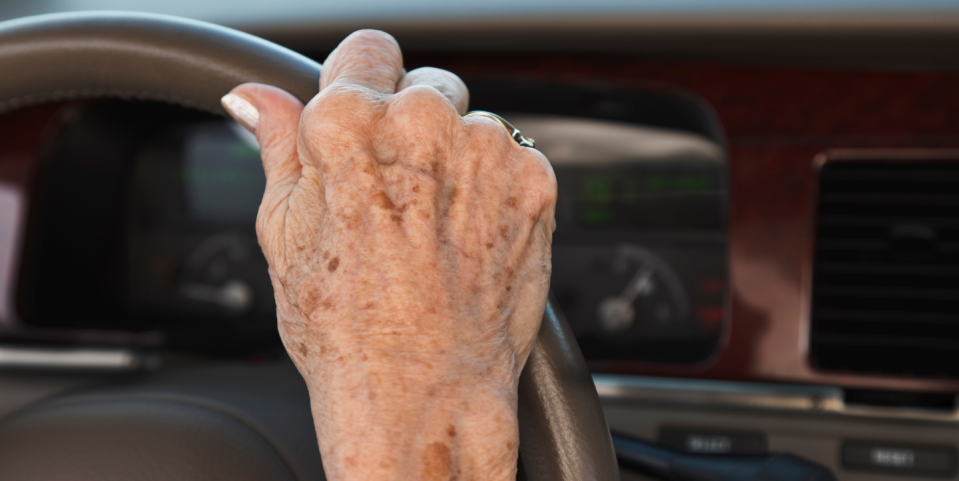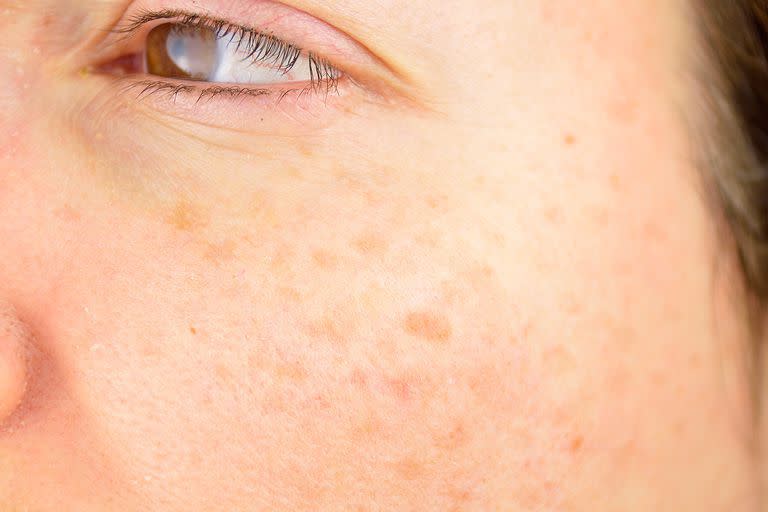The Most Effective Ways to Get Rid of Annoying Age Spots Before They Get Darker

There’s nothing quite like looking in the mirror—or down at your hands—to discover spots and freckles you could swear weren’t there yesterday. Even though most of us have experienced our share of hyperpigmentation, we’re also fortunate enough to have tons of options at our disposal to, well, remove those annoying age spots before they get any worse.
So what are age spots, anyway? “Also known as sun spots or solar lentigines, age spots are benign pigmented spots typically caused by ultraviolet radiation from the sun,” says Noelani González, MD, board-certified dermatologist and director of cosmetic dermatology at Mount Sinai West in New York. UV rays cause our pigment-producing skin cells to increase melanin production, resulting in those pesky brown spots.
If you have a family history of age spots, you’re more prone to developing them when you’re exposed to the sun (or tanning beds). They usually appear as flat brown spots on the areas of skin that are exposed to the sun most—face, neck, chest, hands, arms, and back—but can also appear as seborrheic keratosis, which are raised, wart-like skin growths.
When it comes to age spots, prevention is everything
Even though age spots are usually no biggie, it’s crucial to prevent sun damage not only for aesthetic purposes, but to stay protected against skin cancer, says New York City-based board-certified dermatologist Ariel Ostad, MD, who recommends amping up your sun safety habits—like frequently applying broad spectrum sunscreen, staying out of the sun during its most powerful hours (12 p.m. to 5 p.m.), and covering your body with clothing and hats, as able.
As for the age spots that have already turned up on your skin? Here are the most effective over-the-counter and in-office treatments that dermatologists recommend.
How to get rid of age spots

Sunscreen
“The best OTC option to minimize current (and prevent future) age spots is sunscreen,” says Dr. González. Not only will sunscreen prevent the age spots you already have from getting darker, it will also keep future ones from forming. Experts recommend choosing sunscreen that offers broad-spectrum protection of SPF 30 or higher, such as Neutrogena Sheer Dry-Touch, EltaMD UV Clear, Cotz Flawless Complexion, and CeraVe Hydrating.
Non-prescription lightening creams and serums
OTC lightening creams help to reduce age spots by suppressing the production of melanin, says Anthony Youn, MD, board-certified plastic surgeon and author of The Age Fix. (Just note that they are most effective on age spots that have been caught early and are still on the lighter side.)
If you’d like to give this option a whirl, the active ingredients to look for are hydroquinone, glycolic acid, kojic acid, licorice root extract, and niacinamide. Hydroquinone is considered the gold standard of lightening, but is known for being harsher on skin and may trigger side effects, such as skin irritation and rebound pigmentation if it’s applied for too long, says Dr. Youn.
Dr. González’s top OTC picks include Skin Medica’s Lytera 2.0 Pigment Correcting Serum and SkinCeuticals Discoloration Defense: “Both contain tranexamic acid, an ingredient also known for its lightening capabilities that tends to be less irritating than hydroquinone for some,” she says. She also recommends Murad Age Spot and Pigment Lightening Gel—it contains hydroquinone and glycolic acid, which helps to exfoliate the top layer of your skin.
If you struggle with spots on your face, you could also try incorporating a vitamin C serum into your daily routine. Since vitamin C is an antioxidant, it helps to protect the skin against sun damage, prevents dark spots, and gives an overall brightening effect.
Prescription fade creams
Prescription topical drugs can work slowly to lighten age spots (think: several weeks to months), the two most commonly prescribed being hydroquinone and tretinoin. Hydroquinone works by slowing the production of melanin, says Dr. Ostad, while tretinoin is a retinol cream that can improve skin texture and reduce pigmentation. Side effects are typically minimal, but can include itching, redness, or dryness.
Cryotherapy
During this in-office procedure, liquid nitrogen (a freezing agent) is applied to the age spots. “This freezes and destroys the pigment-making cells, causing the spots to flake off,” says Dr. González. As the skin heals, it appears lighter. This treatment is best for single age spots or small clusters of them, and can be done a few times a month if necessary.
Chemical peels
Depending on the depth of the peel, this treatment can be helpful in reducing the appearance of age spots, says New Jersey-based board-certified dermatologist Shari Sperling, DO. It involves your dermatologist applying an acid to the area, which burns the outer layer of your skin to where the age spots are camping out. As this layer of skin sloughs off, a new layer replaces it. The number of treatments needed vary based on the severity of the age spots and type of peel—side effects can range from none to a few days of peeling/dryness, says Dr. Sperling.
Intense pulsed light (IPL)
“Hands down, the easiest and most effective option for age spots is IPL,” says Dr. Youn, which uses light to target the color brown. “This destroys the pigment, causing the age spot to turn darker and slough off after about a week,” he explains. Most people require upwards of four treatments for optimal effect. Bonus: There’s no downtime and the treatment is virtually pain-free.
Laser treatments
Depending on your skin color, skin tone, and the location of your age spots, there are several types of laser treatments that can help. This is the preferred method of nixing age spots for dermatologists, thanks to the quicker recovery time and longer-lasting results. “The PicoWay is an especially effective laser to treat age spots, as the advanced laser uses ultra-short picosecond pulses to break up particles of skin pigmentation,” says Dr. Ostad.
Fraxel laser treatments are also a great option for age spots, he says. The technique uses a fractional laser (a focused beam of light that’s broken into a multitude of pinpoints) to deliver heat into the skin. This vaporizes the pigmented skin cells, while encouraging collagen remodeling in deep skin layers—and in addition to a reduction in age spots, results in tighter, smoother skin.
Stay updated on the latest science-backed health, fitness, and nutrition news by signing up for the Prevention.com newsletter here. For added fun, follow us on Instagram.
('You Might Also Like',)
